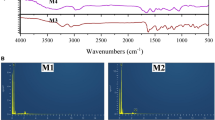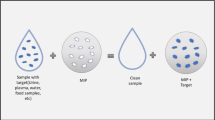Abstract
A series of β-cyclodextrin derivatives were designed and synthesized. The derivatives were investigated as functional monomers in molecularly imprinted polymeric solid-phase microextraction (MIP-SPME) fiber coatings. The coatings, with a layer thickness of 250 μm, were immobilized onto stainless steel using a capillary tube as a mold. This study employed a simple, easy, and reproducible method to prepare uniform coatings for polychlorophenols extraction. The combination of molecular inclusion effects and the molecular imprinting sites was expected to enhance the molecular recognition ability for polychlorophenols. Compared with non-imprinted polymer coatings and MIP coatings with methacrylic acid as the functional monomer, the β-cyclodextrin MIP-SPME coatings exhibited significantly higher extraction amounts and excellent selectivity to the template of triclosan. The MIP-SPME coatings exhibited a favorable synergistic extraction capacity resulting from the β-cyclodextrin cavity and molecularly imprinted binding sites. The method of β-cyclodextrin MIP-SPME coupled with high performance liquid chromatography (HPLC) for triclosan and polychlorophenols analysis in real water samples was developed. The limit of quantification was 1 μg/L for the three polychlorophenols. The recovery for three analytes ranged from 83.71% to 109.98%, with the relative standard deviation (RSD) of 2.83% to 12.19%. The β-cyclodextrin MIP-SPME fiber coatings could be used for at least 100 cycles.

Synergistic effects in β-cyclodextrin MIP-SPME








Similar content being viewed by others
References
Arthur CL, Pawliszyn J. Solid-phase microextraction with thermal-desorption using fused-silica optical fibers. Anal Chem. 1990;62(19):2145–8.
Martín-Esteban A. Molecularly-imprinted polymers as a versatile, highly selective tool in sample preparation. Trends Anal Chem. 2013;45:169–81.
Hu YL, Pan JL, Zhang KG, Lian HX, Li GK. Novel application of molecularly-imprinted polymers in sample preparation. Trends Anal Chem. 2013;43:37–52.
Koster EHM, Crescenzi C, Hoedt WD, Ensing K, de Jong GJ. Fibers coated with molecularly imprinted polymers for solid-phase microextraction. Anal Chem. 2001;73:3140–5.
Mullett WM, Martin P, Pawliszyn J. In-tube moleculary imprinted polymer solid-phase microextraction for the selective determination of propranolol. Anal Chem. 2001;73:2383–9.
Tamayo FG, Turiel E, Martínesteban A. Molecularly imprinted polymers for solid-phase extraction and solid-phase microextraction: recent developments and future trends. J Chromatogr A. 2007;1152(1/2):32.
Turiel E, Tadeo JL, Martínesteban A. Molecularly imprinted polymeric fibers for solid-phase microextraction. Anal Chem. 2009;32(19):3278–84.
Liu RM, Feng F, Chen GL, Liu ZM, Xu ZG. Barbell-shaped stir bar sorptive extraction using dummy template molecularly imprinted polymer coatings for analysis of bisphenol A in water. Anal Bioanal Chem. 2016;408:5329–35.
Sun XL, Wang JC, Li Y, Jin J, Zhang BQ, Shah SM, et al. Highly selective dummy molecularly imprinted polymer as a solid-phase extraction sorbent for five bisphenols in tap and river water. J Chromatogr A. 2014;1343:33–41.
Surikumaran H, Mohamad S, Sarih NM, Raoov M. β-Cyclodextrin based molecularly imprinted solid phase extraction for class selective extraction of priority phenols in water. Sep Sci Technol. 2015;50:2342–51.
Che XM, Yan KG, Xiao XH, Li GK. Analysis of forchlorfenuron and thidiazuron in fruits and vegetables by surface-enhanced Raman spectroscopy after selective solid-phase extraction with modified β-cyclodextrin. J Sep Sci. 2016;39(12):2340–6.
Egawa Y, Shimura Y, Nowatari Y, Aiba D, Juni K. Preparation of molecularly imprinted cyclodextrin microspheres. Int J Pharm. 2005;293:165–70.
Zhang W, Qin L, He XW, Li WY, Zhang YK. Novel surface modified molecularly imprinted polymer using acryloyl-β-cyclodextrin and acrylamide as monomers for selective recognition of lysozyme in aqueous solution. J Chromatogr A. 2009;1216:4560–7.
Zhang Y, Li YW, Hu YL, Li GK, Chen YQ. Preparation of magnetic indole-3-acetic acid imprinted polymer beads with 4-vinylpyridine and β-cyclodextrin as binary monomer via microwave heating initiated polymerization and their application to trace analysis of auxins in plant tissues. J Chromatogr A. 2010;217(47):7337–44.
Sedghi R, Heidari B, Yassari M. Novel molecularly imprinted polymer based on β-cyclodextrin@graphene oxide: synthesis and application for selective diphenylamine determination. J Colloid Interface Sci. 2017;503:47–56.
Yang C, Nie J, Li Z, Zhen Y, Xu G, Li H, et al. A molecularly imprinted polymer synthesized using β-cyclodextrin as the monomer for the efficient recognition of forchlorfenuron in fruits. Anal Bioanal Chem. 2017;409(21):5065.
Asanuma H, Akiyama T, Kajiya K, Hishiya T, Komiyama M. Molecular imprinting of cyclodextrin in water for the recognition of nanometer-scaled guests. Anal Chim Acta. 2001;435:25–33.
Li SH, Wu XJ, Zhang Q, Li PP. Synergetic dual recognition and separation of the fungicide carbendazim by using magnetic nanoparticles carrying a molecularly imprinted polymer and immobilized β-cyclodextrin. Microchim Acta. 2016;183:1433–9.
Liu XY, Fang HX, Yu LP. Molecularly imprinted photonic polymer based on β-cyclodextrin for amino acid sensing. Talanta. 2013;116:283–9.
Guo MJ, Hu X, Fan Z, Liu J, Wang XC, Wang Y, et al. Molecularly imprinted photonic polymer based on p-cyclodextrin for amino acid sensing. Talanta. 2013;105:409–16.
Cheng Y, Dong XC. Preparation of molecularly imprinted fluorescent chemosensor using quinoline modified vinyl-β-cyclodextrin and acrylamide as monomers for selective recognition of spermidine. Anal Methods. 2016;8:5838–42.
Matsui T, Osawa T, Shirasaka K, Katayama M, Hishiya T, Asanuma H, et al. Improved method of molecular imprinting of cyclodextrin on silica-gel surface for the preparation of stable stationary HPLC phase. J Incl Phenom Macrocycl. 2006;56:39–44.
Qin L, He XW, Li WY, Zhang YK. Molecularly imprinted polymer prepared with bonded beta-cyclodextrin and acrylamide on functionalized silica gel for selective recognition of tryptophan in aqueous media. J Chromatogr A. 2008;1187:94–102.
Hishiya T, Shibata M, Kakazu M, Hiroyuki Asanuma A, Komiyama M. Molecularly imprinted cyclodextrins as selective receptors for steroids. 1. Macromolecules. 1999;7:2265–9.
Kawamura A, Kiguchi T, Nishihata T, Uragami T, Miyata T. Target molecule-responsive hydrogels designed via molecular imprinting using bisphenol A as a template. Chem Commun. 2014;50:11101–3.
Yang Z, Shi D, Chen M, Liu S. Free-standing molecularly imprinted photonic hydrogels based on β-cyclodextrin for the visual detection of l-tryptophan. Anal Methods. 2015;7(19):8352–9.
Michalowicz J, Duda W. Phenols sources and toxicity. Pol J Environ Stud. 2007;16:347–62.
Ribeiro A, Neves MH, Almeida MF, Alves A, Santos L. Direct determination of chlorophenols in land-fill leachates by solid-phase microextraction gas chromatography-mass spectrometry. J Chromatogr A. 2002;975:267–74.
Surikumaran H, Mohamad S, Sarih NM. Molecular imprinted polymer of methacrylic acid functionalized β-cyclodextrin for selective removal of 2,4-dichlorophenol. Int J Mol Sci. 2014;15:6111–36.
Qiu XZ, Liang Y, Guo HS, Wang XB, Lin CX. Determination of phenolic compounds in environmental water by HPLC combination with on-line solid-phase extraction using molecularly imprinted polymers. J Nanosci Nanotechnol. 2015;15:9578–84.
EC Drinking Water Guideline, 98/83/CE, November (1998) European Union, Brussels
Federal Register, EPA method 604, Phenols, Part VIII, 40 CFR Part 136, Washington (1984) US Environmental Protection Agency (EPA)
Yueh MF, Taniguchi K, Chen SJ, Evans RM, Hammock BD, Karin M, et al. The commonly used antimicrobial additive triclosan is a liver tumor promoter. Proc Natl Acad Sci U S A. 2014;111:17200–5.
Louch D, Motlagh S, Pawliszyn J. Dynamics of organic compound extraction from water using liquid-coated fused silica fibers. Anal Chem. 1992;64:1187–99.
Saraullo A, Martos PA, Pawliszyn J. Water analysis by solid phase microextraction based on physical chemical properties of the coating. Anal Chem. 1997;69:1992–8.
Acknowledgements
This work is supported by the National Natural Science Foundation of China (21565018).
Author information
Authors and Affiliations
Corresponding authors
Ethics declarations
Conflict of interest
The authors declare that they have no conflict of interest.
Electronic supplementary material
ESM 1
(PDF 646 kb)
Rights and permissions
About this article
Cite this article
Liu, Y., Liu, Y., Liu, Z. et al. β-Cyclodextrin molecularly imprinted solid-phase microextraction coatings for selective recognition of polychlorophenols in water samples. Anal Bioanal Chem 410, 509–519 (2018). https://doi.org/10.1007/s00216-017-0746-3
Received:
Revised:
Accepted:
Published:
Issue Date:
DOI: https://doi.org/10.1007/s00216-017-0746-3




